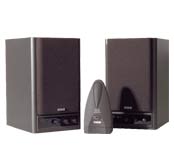 |


TechnoFILE is copyright and a registered trademark © ® of
Pandemonium Productions.
All rights reserved.
E-mail us Here!

Wireless Speakers Add FlexibilityNot Too Hi-Fi, but Convenient By Jim Bray Wireless speakers have come a long way, baby. About a decade ago, I tried a pair that used infrared light to transmit the sound, and I wasn’t impressed. They had a bad hum to them and you had to place them within line of sight of the transmitter or they wouldn’t work. I’ve been playing with a pair of new RCA’s, however, that have fixed those problems for the most part, and that even sound reasonably good, all things considered. RCA’s $230 WSP200 wireless speakers use 900 Megahertz radio frequency (RF) signals, which makes them practical for use at home or cottage. This is basically the same type of technology found in today’s cordless phones. RF signals pass through walls and floors, and this system has a range of up to 150 feet, so you can take them right out of the room in which the transmitter resides and put them almost anywhere. Almost anywhere. While these speakers have cut the wire connecting them to the amplifier, they do require a convenient AC outlet for each speaker – and the wires for the speakers’ AC adapters’ are only about six feet long, so that can limit their placement. I also found the speakers didn’t like working with extension cords, though they seemed happy with power bars. Go figure. Still, it’s one heck of a lot more flexible than those old style wireless speakers. The transmitter unit looks like a little black saddle horn, and comes with yet another AC adapter and a pair of patch cords you plug into your home stereo or whatever other audio source you want to use. The patch cords that came with my sample unit were only three feet long, despite the box saying they were six feet, which meant I needed to have a handy perch nearby for the transmitter. Fortunately, this wasn’t a particularly big deal, since the transmitter’s “footprint” is only about three inches wide by four inches deep – and if other copies of the speakers come with the real six foot cord potential placement problems will probably disappear. A switch on the side of the transmitter lets you turn the system on and off and choose from three channels with which to transmit the sound to the speakers. This latter point gives you some flexibility in finding a clear channel to minimize interference from other RF devices. A corresponding knob on each speaker lets you tune it to the same channel. There’s also a knob that turns on the speaker and controls its volume, and another one that adjusts the tone. The speakers’ amplifiers only put out 8 watts of power, which is about “boombox” territory, but that’s all you really need. Likewise, the signal to noise ratio is “a minimum” of 55 decibels, and total harmonic distortion is rated at two per cent. Frequency response is 50 – 15,000 hertz, and the channel separation is listed as a paltry 25 decibels. These specifications are nothing to write home about in a home stereo system, but these speakers aren’t meant to replace your “real” stereo. We’re obviously talking convenience here, not high fidelity, and as long as you have the aforementioned AC outlets handy, the system offers convenience in spades. I hooked the transmitter into the “tape out” jacks of my main stereo, which is located in the home theater we used to call a family room, and from there I could use the speakers in any other room of the house or even out on the deck in our back yard – much to my neighbors’ chagrin, I’m sure. Putting the speakers outside is where I discovered their disdain for extension cords. I only have two electrical outlets on my deck and they’re right beside each other; if I wanted any kind of reasonable stereo separation I had to get the speakers farther apart than the AC adapters’ cords would allow. It worked out okay in the end, thanks to a power bar and an outlet in the garage. I had hoped to use these speakers for the rear channels of my Dolby Digital system but I don’t think they’re up to that particular job. They’re more than adequate as portable speakers, however – the task for which they were designed – as long as you don’t mind that extreme portability coming with a $230 price tag. Jim Bray's technology columns are distributed by the TechnoFILE and Mochila Syndicates. Copyright Jim Bray.
|
|
|
| Support TechnoFile via Paypal |
| TechnoFILE's
E-letter We're pleased to offer our FREE private, subscription-based private E-mail service. It's the "no brainer" way to keep informed. Our Privacy Policy |